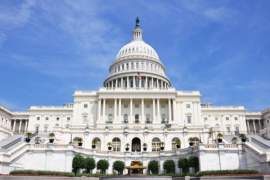
Twenty Fifth Amendment

Popular In Constitution
Purpose Of Lifetime Appointment And Pros And Cons Enumerated Powers Bicameral Legislature Background Article 3 Of The Constitution We The People 1st Amendment Who Wrote The Constitution Judicial Review Equal Protection Clause Three Fifths Compromise 10th Amendment 5th Amendment
The 25th Amendment would address certain procedures regarding the offices of the President and the Vice-President. Most specifically, it entails procedures regarding the succession to the Presidency, as well as determining the process to fill a vacancy in the Vice President office. Further provisions also include for procedures to be taken if the President is to be rendered incapacitated due to disabilities.
The 25th Amendment addresses an important issue that had already been a concern in previous legislation in the United States Constitution, and furthermore, actual events occurring in both the office of the President and Vice-President where confusion as to how to proceed would ensue. Though the Constitution addressed Presidential office procedures in Article II, the text proved to be ambiguous because it did not explicitly state whether the Vice President is to take the Presidential office, rather than just the position of "Acting President." Furthermore, it did not address what procedures were to take place if the President died, resigned, or was removed from office. The 25th Amendment would be ratified by the states on July 6th, 1965.
The 25th Amendment proves to be one of the most
important Constitutional Amendments because it sets forth precedence in the
extenuating circumstance that the President is removed from office, regardless
of the reason. Prior to the 25th Amendment, there was confusion regarding the
procedures and who would then replace the President and to what extent that
person would assume the Presidential office.
The first occurrence of this kind of situation resulted when President William Henry Harrison died while in office. Vice President John Tyler then assumed the role of President, rather than just acquiring the position's powers and responsibilities. Tyler refused to be recognized as "Acting President" and would finally take the oath of office, making him the tenth United States President.
This would become known as the "Tyler Precedent," which would informally establish that the Vice President would take the office of President in the event that the elected President were to die while in office. However, no formal legislation existed establishing such a procedure.
A similar
event would again occur while President Woodrow Wilson was in office and
suffered a stroke. No individual formally assumed the Presidential office
during that time. Furthermore, the office of Vice President has been vacated
sixteen times, with no one assuming the role.
The extenuating circumstances led to the clear
need for Constitutional Amendments that would create guidelines and procedures
if such events were to occur, as well delineating the exact position that the
person assuming the Presidential role would have. Two proposals were sent to
Congress for the new Amendment that would provide for these guidelines, the Keating-Kefauver
proposal and the Bayh-Celler proposal.
The Keating-Kefauver proposal would delegate Congress the power to determine when a President would be considered disabled, and thus, unable to carry out the responsibilities of the position. Concerns would arise dealing with the possible abuse of authority by Congress by giving them such power, and thus, this proposal would be rejected.
The
Bayh-Celler proposal, which is the one the 25th Amendment is ultimately based
on, stated that the Vice President would become "Acting President" in
the case the President would become disabled. It also included procedures
regarding the vacancy of the Vice President office in such a situation.
The 25th Amendment would be divided into four
distinct sections, each addressing particular procedures regarding events in
which the President-Elect would no longer be able to carry out the duties of
the office. Section 1 would include the "Tyler Precedent" as the
accepted procedure under law, wherein the Vice President would assume the
Presidential Office if the President were to die, be removed from office, or
resign.
Section 2 states that in the case that the Vice
President office is vacated, the President would appoint the person to fill
that position in concurrence with a majority vote by both Houses of Congress.
Section 3 deals with the situation in which the
President is disabled. The President must provide a written declaration to the
President pro tempore of the Senate and the Speaker of the House of
Representatives stating that he is unable to carry out his responsibilities.
The Vice President would then serve as "Acting President" until yet
another written declaration is issued by the President stating that he/she is
able to resume the duties of the position.
Section 4 is the only provision that has not been
implemented. This provision gives the authority to the Vice President to
declare the President as disabled by submitting a written declaration to the
President pro tempore of the Senate and the Speaker of the House of
Representatives. This is only to occur if the President him/herself cannot
provide for a written declaration due to the disability.
However, if the President is not disabled to that extent, a written declaration stating that he/she is able to resume the office would reinstate him as President. If the Vice President and the Cabinet are still dissatisfied with the condition of the President, yet another declaration can be submitted. At this juncture, Congress must meet within 48 hours if not in session. Congress must then render a two-thirds vote regarding whether or not the President is capable of carrying out the responsibilities of the office. A period of 21 days is allotted to reach such a decision. If no decision is met, the President would still remain in office. Otherwise, the Vice President would continue as "Acting President."



















